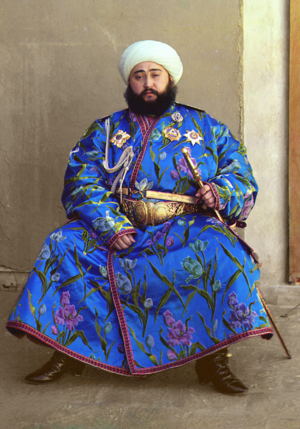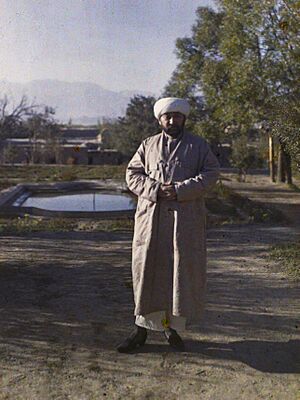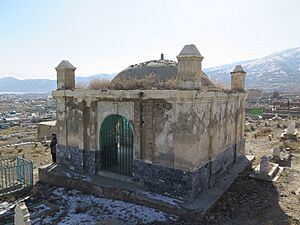Sayyid Mir Muhammad Alim Khan facts for kids
Quick facts for kids Sayyid Mir Mohammed Alim Khan |
|
|---|---|

Alim Khan, photographed in color by Prokudin-Gorsky in 1911
|
|
| Emir of Bukhara | |
| Reign | 3 January 1911 – 30 August 1920 |
| Predecessor | 'Abd al-Ahad Khan |
| Successor | Monarchy abolished |
| Born | 3 January 1880 Bukhara, Emirate of Bukhara (present-day Uzbekistan) |
| Died | 28 April 1944 (aged 64) Kabul, Afghanistan |
| Spouse | 3 |
| Issue |
|
| House | Manghud dynasty |
| Father | 'Abd al-Ahad Khan |
| Religion | Islam |
Emir Sayyid Mir Muhammad Alim Khan (Uzbek: Саид Мир Муҳаммад Олимхон, Said Mir Muhammad Olimxon, January 3, 1880 – April 28, 1944) was the very last emir of Bukhara. An emir was like a king or ruler. He belonged to the Uzbek Manghit family, who ruled the Emirate of Bukhara in Central Asia. Even though Bukhara was under the protection of the Russian Empire from 1873, Alim Khan was still the absolute ruler of his own lands. He reigned from January 3, 1911, until August 30, 1920.
Contents
Early Life and Education
When Alim Khan was thirteen, his father, Emir Abdulahad Khan, sent him away to study. He went to Saint Petersburg in Russia for three years. There, he learned about how to run a government and modern military skills.
In 1896, the Russian government officially named him the Crown Prince of Bukhara. After this, he returned home. He spent two years helping his father manage the government in Bukhara. Then, he became the governor of the Nasef region for twelve years. Later, he moved to rule the northern province of Karmana for two more years. In 1910, he heard that his father had passed away.
Alim Khan's Rule
When Alim Khan first became ruler, he seemed ready to make good changes. He said he would not accept personal gifts. He also stopped officials from asking for bribes or collecting unfair taxes.
However, things changed over time. His ideas about gifts, taxes, and government salaries shifted. There was a power struggle between those who wanted old traditions and those who wanted new reforms. The traditionalists won, and the reformers had to leave. Some historians think Alim Khan might have realized that the reformers wanted to remove him from power. Like the rulers before him, Alim Khan was a traditional leader. He thought about reforms only if they helped him keep control.
Sadriddin Ayniy, a famous Tajik writer, wrote about life under the Emir. He was punished for speaking Tajik. He later wrote a book about his experiences.
Alim Khan was the only Manghud ruler to use the title of Caliph. He was also the last ruler from the Manghit dynasty. Between 1914 and 1916, the Nodir Devonbegi Khanaka building was repaired by Olim Khan.

In March 1918, a group called the Young Bukharan Movement told the Bolsheviks that Bukhara was ready for a revolution. The Red Army marched to Bukhara and demanded that the emir give up the city. Russian reports say that the emir responded by killing the Bolshevik group. He also killed many Russian supporters in Bukhara. Most people in Bukhara did not support an invasion. The Red Army was not ready, so they went back to Tashkent.
Overthrow and Later Life
The emir's victory was only for a short time. As the civil war in Russia ended, Moscow sent more soldiers to Central Asia. On September 2, 1920, a strong Red Army force attacked Bukhara. This army was led by General Mikhail Frunze.
After four days of fighting, the Ark of Bukhara was destroyed. The red flag was raised on top of the Kalyan Minaret. Emir Alim Khan had to flee. He first went to Dushanbe (in modern-day Tajikistan). Then he went to Kabul, Afghanistan, where he died in 1944. He is buried in the Shuadoi Solehin cemetery.
Family Life
The exact number of children Alim Khan had is not known. He had three official wives in Bukhara. After he moved to Afghanistan, many people there felt sorry for him. They offered their daughters to him as wives. So, he had several more wives in Afghanistan. Some people believe he had about 500 children. Almost all of his children were with him during his last years.
In August 1920, the Red Army surrounded Bukhara. Alim Khan quickly tried to leave with his family and close friends. But because they had to leave so fast, three of his young sons were left behind. Their names were Sultanmurad, Shahmurad, and Rahimkhan. They were about 8–10 years old.
After Bukhara was captured, the Bolsheviks found the boys. They first thought about killing them. But they decided to keep them alive for their own purposes. They sent all three boys to Moscow. There, they were raised in an orphanage for children of dead Bolsheviks.
Seyid Alim Khan asked the Bolsheviks and the world to release his children. He wanted them to join him in Afghanistan. But the Bolsheviks refused. They kept the children as hostages for political reasons.
Sultanmurad, the oldest of the three sons, was disabled from birth. He studied and then worked at a factory for disabled people. He was later arrested by the NKVD, which was a secret police force. He was called an "enemy of the people." He was accused of working with British spies. After his arrest, Sultanmurad went on a hunger strike and died.
Rahimkhan, the youngest son who stayed in the USSR, tried to escape the country before World War II. He was caught by Soviet border guards near the border with Afghanistan. He was then sentenced to death and executed by a firing squad.
Shahmurad, the middle son, was also in the Moscow orphanage. In 1922, he was sent to study in Germany. This was part of a plan to train new young leaders for the new republic. He was given a new name, "Alimov Shah Muratovich." After returning, he spoke German very well. He also studied about the coal industry.
Shahmurad wanted to be a soldier. But he could not join a military school because his father was considered an "enemy of the people." So, he decided to publicly disown his father. In 1930, he wrote an open letter to his father in a newspaper. In the letter, he said he no longer supported Seyid Alim Khan. He accused his father of bad deeds. Some believe the NKVD made him do this.
Later, Shahmurad joined a military engineering academy in Moscow. He taught there after he graduated. He served in the Red Army and became a major general. He fought in World War II and lost a leg. He received an award called the Order of the Red Banner. After the war, he taught again at the academy. He then married Lidia Mikhailovna.
Alim Khan's daughter, Shukria Alimi Raad, worked as a broadcaster for Radio Afghanistan. She left Afghanistan with her family in 1979 when Soviet troops invaded. She went to Pakistan, then Germany, and finally to the United States. In 1982, she started working for the Voice of America. She worked there for many years as a broadcaster, editor, and producer.
Alim Khan also had a son named Qasem during his rule in Bukhara. Qasem was killed by the Bolsheviks. Qasem had one son who, at age 13, escaped to Mashhad, Iran. He took the name Husein Bukharaei. He married Bibimeymanat Mohsenolhoseini in Mashhad. They had 6 sons and 4 daughters. Husein Bukharaei died in 1993. His children (Hasan, Lo'ba, Ali, Narges, Qasem, Reza, Fatemeh, Mohammad, Mahmoud, Mahboubeh) all live in Mashhad.
In 2020, the BBC World Service made a documentary called Bukhara. It talked about Emir Alim Khan and what happened to his family.
Alim Khan's grandchildren include Nailaj Naebzadeh, from his daughter Razia Alimi. His great-granddaughter is Kadeij Naebzadeh. Salim Islamzada is his grandson through his mother Shamsia Alimi. His great-granddaughters are Sadaf, Zohra, and Fereshta Islamzada. All of them live in the United States. Nailaj Naebzadeh was born in the United States. Her mother, Razia Alimi, also escaped from Afghanistan during the Soviet invasion in 1979.
Images for kids
-
Alim Khan's house in Saint Petersburg



